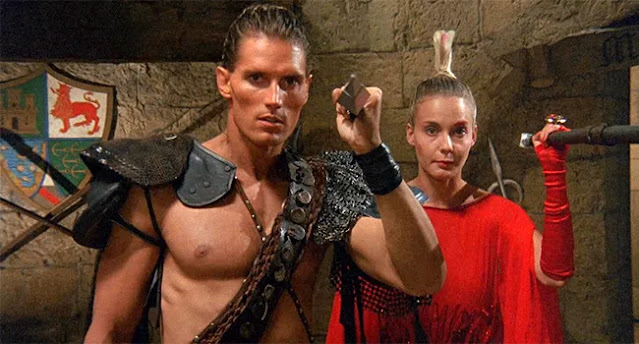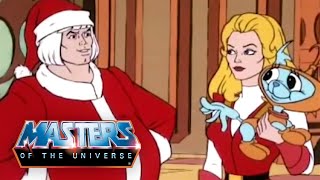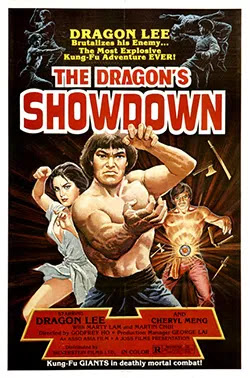PHENOMENALITY: *marvelous*
MYTHICITY: *good*
FRYEAN MYTHOS: *adventure*
CAMPBELLIAN FUNCTION: *psychological*
SPOILERS SPOILERS SPOILERS
IRON WARRIOR, according to online sources, was made by both a different director and production team than the people who made the first two ATOR films. WARRIOR has a lot of the same loopy imagery seen in director Alfonso Brescia's cheapjack space operas, like STAR ODYSSEY. Yet there's more coherence in this sword-and-sorcery opus, which may be due to Brescia's co-writer Steven Luotto. The Brescia-Luotto abandons even the loose continuity of the first two films and designs a completely new origin for heroic Ator (Miles O'Keeffe).
Like many films of magical fantasy, WARRIOR emphasizes a generational conflict that leads the hero or heroes into their operatic destiny. Ugly old witch Phoedra (Elisabeth Kaza) seeks out two young boys playing ball in a labyrinth (standing stones courtesy of Malta's tourist attractions), and she steals one of the boys. Shortly thereafter, Phoedra is called on the carpet by her fellow sorceresses, who employ the spinning-hoop effect from Richard Donner's SUPERMAN while they rail at her. According to the backstory related by chief good witch Deeva (Iris Peynado), the sorceresses seem to have been around for centuries, guiding the destiny of mankind with the aid of a "Golden Chest of the Ages" that isn't mentioned again for a long time. Phoedra, though, gained control of a mortal kingdom and ruled it tyrannically. Later the old harridan will say that her kingdom was stolen by the "father's father" of the current king, but Phoedra also blames Deeva for driving her from power.
Why does Phoedra wait two generations to begin her dire plot of vengeance? Since all of the witchy "sisters" seem to have prophetic powers, maybe Phoedra knows that Deeva has future plans for Phoedra's former kingdom, plans that involve the two boys, Ator and Trogar. Deeva claims in the dubbed movie to have "created" both kids, which maybe makes her sort of a "good mother" as against Phoedra's child-stealing "bad mother," though I'm not sure either one is worth writing home about. Phoedra won't tell the other witches where she's hidden the boy Trogar (whose name sounds like a part-anagram of Ator), so they remove her power to kill and banish her, though Phoedra doesn't seem very restricted in her ability to cast spells and move from place to place.
Eighteen years pass, during which time Ator grows to manhood, while Phoedra molds his brother into a skull-headed warrior, The Iron Warrior of the title. In addition, Deeva says that she's made certain that the current king of the unnamed kingdom has conceived an heir, though again she doesn't specifically say that she mothered the king's heir, Princess Janna (Savina Gersak). Deeva wanted both Ator and Trogar to be Janna's protectors, so Phoedra, knowing this, subverted Trogar to be her pawn against the reign of Janna.
Phoedra visits the court of heir apparent Janna and makes dire predictions echoing those of Sleeping Beauty's Bad Fairy, though Janna is nothing but courteous while her father wants the witch dead. Phoedra, more impatient than the Bad Fairy, brings forth the Iron Warrior, who slaughters the king's tiny number of guards while Phoedra's magic kills the king. Though the monarch manages to send his daughter away, she's next seen running along a cliffside all alone, so that she's easily captured by the Warrior and a bunch of gibbering dwarves.
It's not clear where Ator has been all this time-- certainly not at the court protecting the princess! But he's on his way there, possibly prompted by Deeva, since she later appears to him in a vision. Phoedra sees him coming, so she changes herself into a pretty young thing, so that Ator can rescue her from some of Phoedra's own warriors. Ator takes the hot babe to a cabin somewhere, and she sleeps with him, so that he'll fall asleep post-coitus. Then she sets the cabin ablaze, but Deeva wakes Ator up and he gets clear. Possibly she guides him to Janna, for Ator finds his way there just as the Warrior's minions are about to sacrifice the princess. Ator routs the dwarves and battles the Iron Warrior, who obligingly disappears for the time being.
From then on, Ator and Janna fulfill the same pattern seen in the first ATOR, running from pillar to post as they're pursued by the villain's minions. Naturally, the potential of romance blooms, and also like the first ATOR, there's a potential sibling relationship between the two youths. The script isn't hesitant to link this transgression to Ator's having slept with "the bad mother." During one of the duo's peregrinations, Ator experiences a weird vision in which he approaches Janna from behind-- though she's clad in the blue outfit of the hot babe, not her usual red garments-- and when "Janna" turns around, she has the face of Phoedra. The vision ends, but Phoedra's magic has had real effects, as the real Janna's red outfit has also turned blue, and stays so from then on.
Eventually, the twosome find their way to the hidden caverns where Deeva alone holds court. She makes various excuses as to why everything that's happened had to happen, and reveals that the Iron Warrior is Trogar. Though Deeva claimed earlier that her power was secure because she had that Golden Chest of the Ages, now she asserts that Ator and Janna must seek out the Chest in some Atlantis-sounding domain, "the Kindgom Beneath the Waves." Only with the Chest can they defeat Phoedra and liberate the enslaved Trogar.
Ator and Janna journey to the deserted city (played by the famous architecture of the island of Malta) and look for the Chest. They're chased through corridors by what seems an automated defense, a big rolling rock like the one from RAIDERS OF THE LOST ARK, but able to change directions to chase them. The RAIDERS vibe is reinforced when the heroes steal the Golden Chest, causing the whole place to fall apart (though of course no real buildings were harmed in the making of the film).
Then Phoedra's warriors show up to fight Ator. Janna gets in one good sword-stab at the enemies herself, and then she and Ator flee the now sinking island. Then Phoedra shows up at Deeva's cave, using her magic to freeze Deeva in a slab of ice and revealing that she already has the real Golden Chest, while Ator and Janna have a fake box holding deadly peril. She doesn't explain why she bothered sending those soldiers to the Wave-Kingdom, nor why, when Ator and Janna arrive at shore, the Iron Warrior's waiting for them. Maybe she just can't resist the irony of having brother battle brother to the death. Ator stabs his possessed brother to death and then mourns.
Ator and Janna return to Deeva's cave, where Phoedra poses as the good witch and accepts from them the fake Golden Chest, which doesn't end up serving any purpose at all. Ator then takes Janna back to her court, but at some point Phoedra makes a switch again, sending along a fake Janna with Ator. But apparently Fake-Janna reveals herself too soon, causing Ator to go looking for Real-Janna again. Phoedra, instead of killing Janna quickly, torments her by hanging her over the side of a cliff (but only after putting her in new clothes). Ator fights more of Phoedra's mounted warriors-- the only half-decent fight-scene in the film-- and then tries to stab Phoedra to death, without success. He can't kill the Bad Mother with his blade-- and why should he be able to, since she already enjoyed his other "blade" earlier? But since the movie needs Phoedra to die, Ator suddenly guesses that the witch is vulnerable to fire, sticks a torch in her mouth (oral fixation, anyone?), and her flaming body meets the fate intended for Janna, going over the cliff.
Then, in a tour de force of wacky resolutions, Ator finds Janna, not hanging over a cliff like before, but trussed up on a sacrificial altar again. He frees her, and as symbolic sister and symbolic brother embrace, one seems to hear the cackle of old Phoedra. Has the witch fooled the noble hero once again?
Well, no. We return to the sanctuary of the Good Witches again. Three sorceresses, only seen before in that opener yelling at Phoedra, then explain the ending for the confused viewer. On either side the witches are flanked by Phoedra (or her spirit), imprisoned in those energy-hoops again, and by Deeva, frozen in the same slab of ice in which Phoedra left her. The witches, so exultant at the triumph of good that they explain things to each other, claim that Phoedra couldn't kill Janna directly because of a limitation Deeva placed on Phoedra's powers at the film's beginning. They don't explain why Phoedra, expecting Ator's advent, left Janna where Ator could find her, but they confirm that it's the real Janna, and that if she has a witchy smile as she welcomes her hero, it's because "there is no witch like a woman in love." Good will now rule the fantasy-world for centuries to come, and the world will be better off now that both the manipulative Bad Mother and the manipulative Good Mother are out of the way.
Since I've noted the many mangled plot-lines of IRON WARRIOR, a part of me does not want to rate the movie's mythicity as highly as I feel I must. But even if the story doesn't make much sense in terms of verisimilitude, there is a consistent symbolic discourse going on here, however rough. Luigi Cozzi's 1983 HERCULES ends with the unjustified suggestion that all the women who have assailed the hero are in reality one woman, but Brescia and Luotto keep the one-woman symbolism weaving through their movie like Ariadne's thread in the Minotaur's labyrinth. A few years later, Ator's director/co-creator Joe D'Amato returned to the hero for his last outing in 1990's QUEST FOR THE MIGHTY SWORD. Maybe D'Amato felt challenged by the pretenders to his barbarian throne, for he worked a lot more clansgressive elements into QUEST than were seen in his first two ATOR films. But D'Amato failed to make all the symbolic elements cohere, while Brescia and Luotto succeed. albeit in a very wonky manner. This was incidentally O'Keeffe's final performance as Ator, and he's just as much a wooden block as when he started. Savina Gersak has more range, but the acting honors go to Elizabeth Maza for her sheer gusto in the role of Phoedra-- whose name, despite the variant spelling, is surely meant to evoke the memory of one of Greek myth's most famous bad mothers.



















